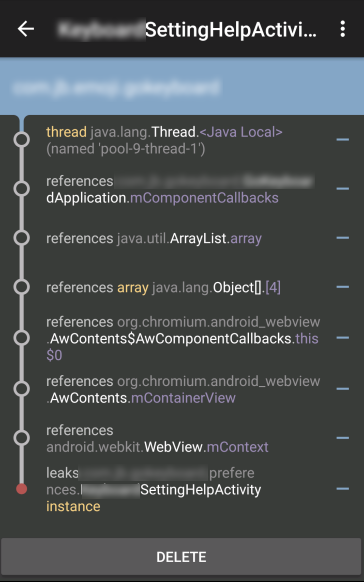问题背景
在排查项目内存泄漏过程中发现了一些由WebView引起的内存泄漏,经过测试发现该部分泄漏只会出现在android 5.1及以上的机型。虽然项目使用WebView的场景并不多,但秉承着一个泄漏都不放过的精神,我们肯定要把它给解决了。
遇到的问题
项目中使用WebView的页面主要在FAQ页面,问题也出现在多次进入退出时,发现内存占用大,GC频繁。使用LeakCanary观察发现有两个内存泄漏很频繁:

我们分析一下这两个泄漏:
从图一我们可以发现是WebView的ContentViewCore中的成员变量mContainerView引用着AccessibilityManager的mAccessibilityStateChangeListeners导致activity不能被回收造成了泄漏。
引用关系:mAccessibilityStateChangeListeners->ContentViewCore->WebView->SettingHelpActivity
从图二可以发现引用关系是: mComponentCallbacks->AwContents->WebView->SettingHelpActivity
问题分析
我们找找mAccessibilityStateChangeListeners 与 mComponentCallbacks是在什么时候注册的,我们先看看mAccessibilityStateChangeListeners
AccessibilityManager.java
private final CopyOnWriteArrayList<AccessibilityStateChangeListener>
mAccessibilityStateChangeListeners = new CopyOnWriteArrayList<>();
/**
* Registers an {@link AccessibilityStateChangeListener} for changes in
* the global accessibility state of the system.
*
* @param listener The listener.
* @return True if successfully registered.
*/
public boolean addAccessibilityStateChangeListener(
@NonNull AccessibilityStateChangeListener listener) {
// Final CopyOnWriteArrayList - no lock needed.
return mAccessibilityStateChangeListeners.add(listener);
}
/**
* Unregisters an {@link AccessibilityStateChangeListener}.
*
* @param listener The listener.
* @return True if successfully unregistered.
*/
public boolean removeAccessibilityStateChangeListener(
@NonNull AccessibilityStateChangeListener listener) {
// Final CopyOnWriteArrayList - no lock needed.
return mAccessibilityStateChangeListeners.remove(listener);
}上面这几个方法是在AccessibilityManager.class中定义的,根据方法调用可以发现在ViewRootImpl初始化会调用addAccessibilityStateChangeListener 添加一个listener,然后会在dispatchDetachedFromWindow的时候remove这个listener。
既然是有remove的,那为什么会一直引用着呢?我们稍后再分析。
我们再看看mComponentCallbacks是在什么时候注册的
Application.java
public void registerComponentCallbacks(ComponentCallbacks callback) {
synchronized (mComponentCallbacks) {
mComponentCallbacks.add(callback);
}
}
public void unregisterComponentCallbacks(ComponentCallbacks callback) {
synchronized (mComponentCallbacks) {
mComponentCallbacks.remove(callback);
}
}上面这两个方法是在Application中定义的,根据方法调用可以发现是在Context 基类中被调用
/**
* Add a new {@link ComponentCallbacks} to the base application of the
* Context, which will be called at the same times as the ComponentCallbacks
* methods of activities and other components are called. Note that you
* <em>must</em> be sure to use {@link #unregisterComponentCallbacks} when
* appropriate in the future; this will not be removed for you.
*
* @param callback The interface to call. This can be either a
* {@link ComponentCallbacks} or {@link ComponentCallbacks2} interface.
*/
public void registerComponentCallbacks(ComponentCallbacks callback) {
getApplicationContext().registerComponentCallbacks(callback);
}
/**
* Remove a {@link ComponentCallbacks} object that was previously registered
* with {@link #registerComponentCallbacks(ComponentCallbacks)}.
*/
public void unregisterComponentCallbacks(ComponentCallbacks callback) {
getApplicationContext().unregisterComponentCallbacks(callback);
}根据泄漏路径,难道是AwContents中注册了mComponentCallbacks未反注册么?
只有看chromium源码才能知道真正的原因了,好在chromium是开源的,我们在android 5.1 Chromium源码中找到我们需要的AwContents(自备梯子),看下在什么时候注册了
AwContents.java
@Override
public void onAttachedToWindow() {
if (isDestroyed()) return;
if (mIsAttachedToWindow) {
Log.w(TAG, "onAttachedToWindow called when already attached. Ignoring");
return;
}
mIsAttachedToWindow = true;
mContentViewCore.onAttachedToWindow();
nativeOnAttachedToWindow(mNativeAwContents, mContainerView.getWidth(),
mContainerView.getHeight());
updateHardwareAcceleratedFeaturesToggle();
if (mComponentCallbacks != null) return;
mComponentCallbacks = new AwComponentCallbacks();
mContext.registerComponentCallbacks(mComponentCallbacks);
}
@Override
public void onDetachedFromWindow() {
if (isDestroyed()) return;
if (!mIsAttachedToWindow) {
Log.w(TAG, "onDetachedFromWindow called when already detached. Ignoring");
return;
}
mIsAttachedToWindow = false;
hideAutofillPopup();
nativeOnDetachedFromWindow(mNativeAwContents);
mContentViewCore.onDetachedFromWindow();
updateHardwareAcceleratedFeaturesToggle();
if (mComponentCallbacks != null) {
mContext.unregisterComponentCallbacks(mComponentCallbacks);
mComponentCallbacks = null;
}
mScrollAccessibilityHelper.removePostedCallbacks();
mNativeGLDelegate.detachGLFunctor();
}在以上两个方法中我们发现了mComponentCallbacks的踪影,
在onAttachedToWindow的时候调用mContext.registerComponentCallbacks(mComponentCallbacks)进行注册,
在onDetachedFromWindow中反注册。
我们仔细看看onDetachedFromWindow中的代码会发现
如果在onDetachedFromWindow的时候isDestroyed条件成立会直接return,这有可能导致无法执行mContext.unregisterComponentCallbacks(mComponentCallbacks);
也就会导致我们第一个泄漏,因为onDetachedFromWindow无法正常流程执行完也就不会调用ViewRootImp的dispatchDetachedFromWindow方法,那我们找下这个条件什么时候会为true
/**
* Destroys this object and deletes its native counterpart.
*/
public void destroy() {
mIsDestroyed = true;
destroyNatives();
}发现是在destroy中设置为true的,也就是说执行了destroy()就会导致无法反注册。我们一般在activity中使用webview时会在onDestroy方法中调用mWebView.destroy();来释放webview。根据源码可以知道如果在onDetachedFromWindow之前调用了destroy那就肯定会无法正常反注册了,也就会导致内存泄漏。
问题的解决
我们知道了原因后,解决就比较容易了,就是在销毁webview前一定要onDetachedFromWindow,我们先将webview从它的父view中移除再调用destroy方法,代码如下:
@Override
protected void onDestroy() {
super.onDestroy();
if (mWebView != null) {
ViewParent parent = mWebView.getParent();
if (parent != null) {
((ViewGroup) parent).removeView(mWebView);
}
mWebView.removeAllViews();
mWebView.destroy();
mWebView = null;
}
}还有个问题,就是为什么在5.1以下的机型不会内存泄漏呢,我们看下4.4的源码AwContents
/**
* @see android.view.View#onAttachedToWindow()
*
* Note that this is also called from receivePopupContents.
*/
public void onAttachedToWindow() {
if (mNativeAwContents == 0) return;
mIsAttachedToWindow = true;
mContentViewCore.onAttachedToWindow();
nativeOnAttachedToWindow(mNativeAwContents, mContainerView.getWidth(),
mContainerView.getHeight());
updateHardwareAcceleratedFeaturesToggle();
if (mComponentCallbacks != null) return;
mComponentCallbacks = new AwComponentCallbacks();
mContainerView.getContext().registerComponentCallbacks(mComponentCallbacks);
}
/**
* @see android.view.View#onDetachedFromWindow()
*/
public void onDetachedFromWindow() {
mIsAttachedToWindow = false;
hideAutofillPopup();
if (mNativeAwContents != 0) {
nativeOnDetachedFromWindow(mNativeAwContents);
}
mContentViewCore.onDetachedFromWindow();
updateHardwareAcceleratedFeaturesToggle();
if (mComponentCallbacks != null) {
mContainerView.getContext().unregisterComponentCallbacks(mComponentCallbacks);
mComponentCallbacks = null;
}
mScrollAccessibilityHelper.removePostedCallbacks();
if (mPendingDetachCleanupReferences != null) {
for (int i = 0; i < mPendingDetachCleanupReferences.size(); ++i) {
mPendingDetachCleanupReferences.get(i).cleanupNow();
}
mPendingDetachCleanupReferences = null;
}
}我们可以看到在onDetachedFromWindow方法上是没有isDestroyed这个判断条件的,这也证明了就是这个原因造成的内存泄漏。
问题的总结
使用webview容易造成内存泄漏,如果使用没有正确的去释放销毁很容易造成oom。webview使用也有很多的坑,需多多测试。
使用中遇到问题可以参考该链接:Android之Android WebView常见问题及解决方案汇总 http://www.cnblogs.com/lee0oo0/p/4026774.html





 本文针对WebView在Android 5.1及以上版本中引发的内存泄漏问题进行了深入分析,并提供了详细的解决方案。通过研究源码,发现泄漏源于WebView未能正确解除注册。
本文针对WebView在Android 5.1及以上版本中引发的内存泄漏问题进行了深入分析,并提供了详细的解决方案。通过研究源码,发现泄漏源于WebView未能正确解除注册。

















 988
988

 被折叠的 条评论
为什么被折叠?
被折叠的 条评论
为什么被折叠?








